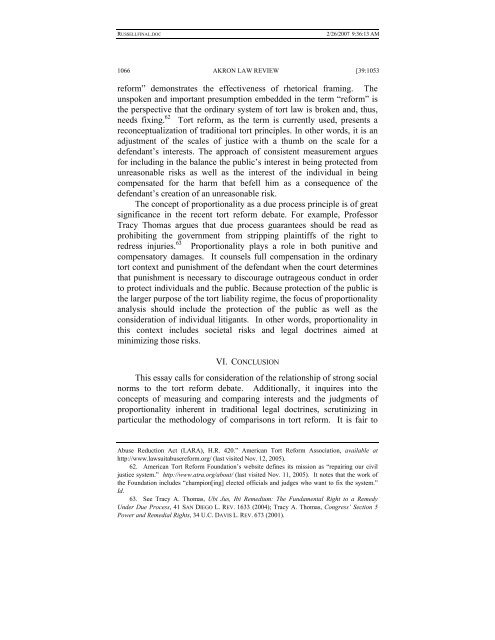THE LOGIC OF LEGAL REMEDIES AND THE RELATIVE WEIGHT ...
THE LOGIC OF LEGAL REMEDIES AND THE RELATIVE WEIGHT ...
THE LOGIC OF LEGAL REMEDIES AND THE RELATIVE WEIGHT ...
You also want an ePaper? Increase the reach of your titles
YUMPU automatically turns print PDFs into web optimized ePapers that Google loves.
RUSSELLFINAL.DOC<br />
2/26/2007 9:36:13 AM<br />
1066 AKRON LAW REVIEW [39:1053<br />
reform” demonstrates the effectiveness of rhetorical framing. The<br />
unspoken and important presumption embedded in the term “reform” is<br />
the perspective that the ordinary system of tort law is broken and, thus,<br />
needs fixing. 62 Tort reform, as the term is currently used, presents a<br />
reconceptualization of traditional tort principles. In other words, it is an<br />
adjustment of the scales of justice with a thumb on the scale for a<br />
defendant’s interests. The approach of consistent measurement argues<br />
for including in the balance the public’s interest in being protected from<br />
unreasonable risks as well as the interest of the individual in being<br />
compensated for the harm that befell him as a consequence of the<br />
defendant’s creation of an unreasonable risk.<br />
The concept of proportionality as a due process principle is of great<br />
significance in the recent tort reform debate. For example, Professor<br />
Tracy Thomas argues that due process guarantees should be read as<br />
prohibiting the government from stripping plaintiffs of the right to<br />
redress injuries. 63 Proportionality plays a role in both punitive and<br />
compensatory damages. It counsels full compensation in the ordinary<br />
tort context and punishment of the defendant when the court determines<br />
that punishment is necessary to discourage outrageous conduct in order<br />
to protect individuals and the public. Because protection of the public is<br />
the larger purpose of the tort liability regime, the focus of proportionality<br />
analysis should include the protection of the public as well as the<br />
consideration of individual litigants. In other words, proportionality in<br />
this context includes societal risks and legal doctrines aimed at<br />
minimizing those risks.<br />
VI. CONCLUSION<br />
This essay calls for consideration of the relationship of strong social<br />
norms to the tort reform debate. Additionally, it inquires into the<br />
concepts of measuring and comparing interests and the judgments of<br />
proportionality inherent in traditional legal doctrines, scrutinizing in<br />
particular the methodology of comparisons in tort reform. It is fair to<br />
Abuse Reduction Act (LARA), H.R. 420.” American Tort Reform Association, available at<br />
http://www.lawsuitabusereform.org/ (last visited Nov. 12, 2005).<br />
62. American Tort Reform Foundation’s website defines its mission as “repairing our civil<br />
justice system.” http://www.atra.org/about/ (last visited Nov. 11, 2005). It notes that the work of<br />
the Foundation includes “champion[ing] elected officials and judges who want to fix the system.”<br />
Id.<br />
63. See Tracy A. Thomas, Ubi Jus, Ibi Remedium: The Fundamental Right to a Remedy<br />
Under Due Process, 41 SAN DIEGO L. REV. 1633 (2004); Tracy A. Thomas, Congress’ Section 5<br />
Power and Remedial Rights, 34 U.C. DAVIS L. REV. 673 (2001).
















